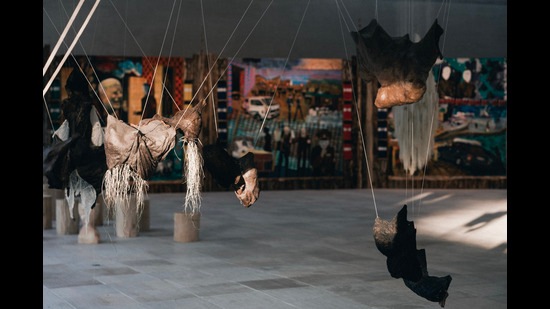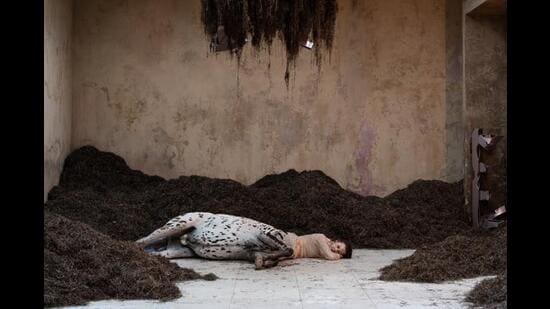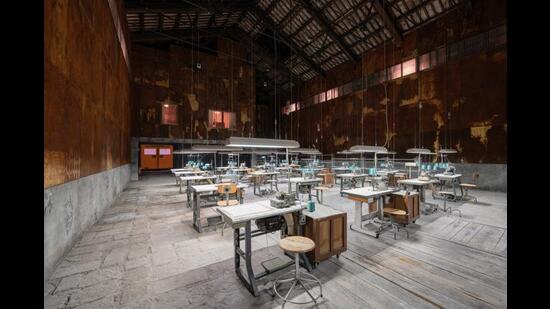Time travel, dying worlds, AI: The most futuristic pavilions at Venice Biennale
National pavilions are taking imaginative leaps at the ‘Olympics of the art world’, examining how media platforms can and have changed the world, asking what it means to be human in a time of artificial intelligence.
Science-fiction and the climate crisis, humans and AI, revolutions past and present, meet at this year’s Venice Biennale (often called the “Olympics of the art world” because of its scale and significance). The 59th edition opened on April 23 and runs until November 27, showcasing work by 213 artists from 58 countries.

The theme of the main show is The Milk of Dreams, after a book by Leonora Carrington in which the Surrealist artist describes “a magical world where life is constantly re-envisioned… where everyone can change, be transformed.”
The national pavilions draw from this theme too, imagining a world without us, exploring contemporary ideas of science and myth; interrogating definitions of “human” and “evolution”. Take a look at five of the most futuristic pavilions.
We Walked the Earth

The Danish Pavilion invites audiences to step into an uncanny world where elements from an idyllic farm life merge with elements of sci-fi to form a haunting image of an uncertain future. We Walked the Earth presents a centaur family of three. In one room, the male has died by suicide and is hanging from a chain suspended from the ceiling. In the adjacent room, the female is lying on the floor, giving birth to a baby that appears to be of a different breed.
The art is a reflection of life, death and the uncertainties that surround life on earth, artist Uffe Isolotto has said. As visitors walk through these spaces, they can see the family’s belongings, food and work tools. It is not obvious what has happened to them and the world they live in.
Scattered impressions
AI is directing part of the show at the Croatian Pavilion. Tomo Savić-Gecan’s untitled performative artwork is designed for the post-truth era.
It involves five performers who receive instructions from an AI algorithm, four times a day. The instructions are shaped by what has made headlines around the world. The performers go where the AI directs them, popping up unpredictably in other pavilions and exhibition spaces. They position themselves as the AI instructs, down to the details of how to move and even what to think about.
What does it mean to be human, the project asks, at a time when technological systems effectively bury objective facts, even as our reactions to the “alternative facts” presented are tracked and mined?
Visitors may experience the project without realising it. For those wishing to seek it out, the Croatian Pavilion and its website offer real-time updates.
2011 ≠ 1848
This exhibition by Stan Douglas unfolds across two venues that make up the Canadian Pavilion. The first exhibit consists of four large images from events in 2011: the Arab Spring; the aftermath of the Stanley Cup riot in Vancouver; youth and police colliding in Hackney during the London riots; and the containment of Occupy Wall Street protesters on the Brooklyn Bridge.
The second exhibition is a video installation housed in a 16th-century salt warehouse, focused on music as a form of transnational cultural resistance.
As its title suggests, 2011 ≠ 1848 compares and contrasts the events of 2011 with those of 1848, which was a year of populist uprisings that began in Sicily and France and then spread across Europe, seeking to topple monarchies and establish republics in their place. The project’s central question is how generational differences in information dissemination can influence the course of a revolt. It was the print media in 1848, social media in 2011.
The Sámi Pavilion
The Nordic Pavilion (representing Sweden, Finland and Norway) has been renamed this time, to acknowledge the indigenous Sámi people who were the original inhabitants of Sápmi or Lapland. The art on display, by artists Pauliina Feodoroff, Máret Anne Sara, and Anders Sunna, speaks of the carnage inflicted on the resisting Sámi by Nordic colonialists.
Sara’s two-part sculpture, for instance, is composed of the stomach and sinews of reindeer, key animals in Sámi culture, highlighted with two scents, one meant to evoke fear, the other hope. Sunna’s painting Illegal Spirits of Sápmi (2022) charts legal battles the Sámi have fought over 50 years, to maintain the right to their traditional practice of reindeer-herding. Sunna, incidentally, is from a family of forest-reindeer herders.
Fate of the Comets

The two-part project on display at the Italian Pavilion is titled History of the Night and Fate of the Comets. Gian Maria Tosatti’s walk-through installation uses the rise and fall of industrial Italy as a metaphor for humankind’s relationship with nature.
The first section, History of the Night, resembles a series of warehouses containing tools, old machinery and tables, all reminiscent of post-industrial decay. The dimly illuminated second section, Fate of the Comets, has blinking bulbs representing light at the end of the tunnel, in contrast with the nothingness of the rest of the room, a metaphor for an unknown future.
A BIENNALE OF FIRSTS
* The pandemic has meant that the Venice Biennale was postponed (from 2021) for the first time since 1944, and only the second time ever.
* It’s an overwhelmingly female biennale, with 191 of the 213 artists being women.
* Five countries are participating for the first time: the Republic of Cameroon, Namibia, Nepal, the Sultanate of Oman, and Uganda.
* Russia’s pavilion has been left empty after the curator and artists withdrew to protest the war in Ukraine. The Ukrainian pavilion is occupied by artist Pavlo Makov displaying his Fountain of Exhaustion, an installation that has taken on added significance since it was also on display in Kyiv at the start of the Russian invasion in February.
Catch your daily dose of Fashion, Health, Festivals, Travel, Relationship, Recipe and all the other Latest Lifestyle News on Hindustan Times Website and APPs.
Continue reading with HT Premium Subscription




